Text
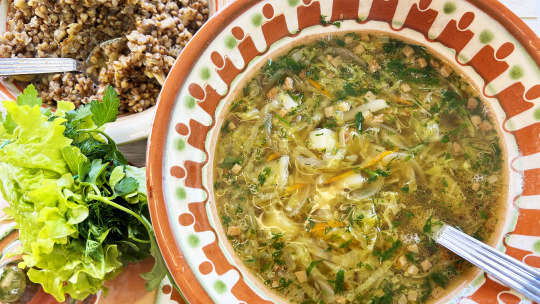
At The Tsar's Table: Cabbage Soup
Although the last Romanov tsar had access to all kinds of luxury, he was not known for his decadence at the imperial table. He preferred simple and healthy food to complex dishes, especially for dessert. He enjoyed light pastries, and tea or coffee was often served with "golden cheese pancakes" (Syrniki) with raspberry jam.
Nicholas II was also a devoted athlete and monitored his health closely. He was known to prefer light dishes that were easy to digest - and he was not a fan of spicy food. Imperial cooks were instructed to use simply salt, pepper and sometimes bay leaves.
He was a big fan of black bread, soups and porridge. One of his favorite dishes was cabbage soup - щи in Russian.
Here's a traditional cabbage soup recipe (supposedly) prepared according to an old recipe from 1913 for the Tsar and served at the Livadia Palace.
Bone broth - 2.5 liters
Lard - 150 g.
Cabbage - 650 g.
Onion - 2 pieces (120 g.)
Carrots - 120 g.
Potatoes - 200 g.
Salt and pepper - to taste
Bay leaf - 2
Fresh herbs (dill, parsley) - 1 bundle
Check this video for all the steps.
22 notes
·
View notes
Text
Nicholas II and his cars
Nicholas II did not rush into the "motor" craze. For two years, he took rides on the car owned by Lt. General A.A. Mossolov until Nicholas' Minister, Count Fredericks, asked the Tsar if he wanted to acquire a motorcar. The Tsar responded quickly: "Yes, of course!
The Tsar fell in love with the automobile. The first car he purchased was a French Delaunay-Belleville which was the Tsar's choice for short trips and in-town use. He liked the German-built Mercedes for long trips…and speed.
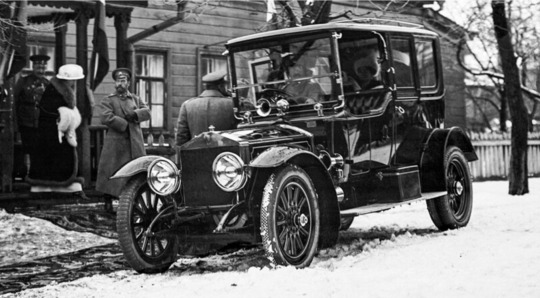
Nicholas II getting into his Rolls Royce
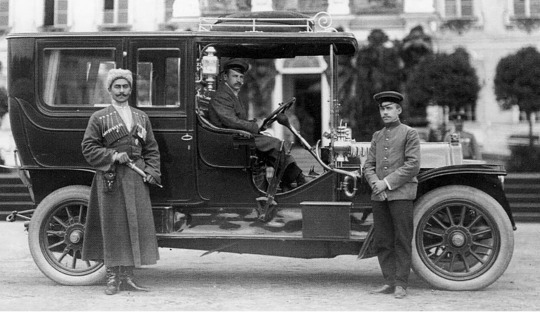
Nicholas II's Mercedes Benz
The Imperial Garages were established in 1905 in Tsarskoe Selo and Peterhof. Later, garages were added in the Winter Palace in St. Petersburg and Livadia Palace in Crimea. There was a budget to maintain the Imperial Garages, which included money to purchase vehicles, training of the drivers (who were responsible for driving and fixing, and maintaining the cars), washers, uniforms for the staff and the brick-and-mortar buildings where the cars were housed. The vehicles served the Tzar, the Empress, the Imperial children, and their suite.
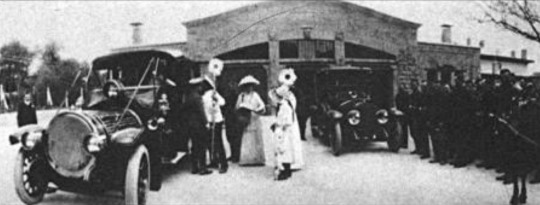
The Imperial family standing by their garages in Livadia

Nicholas is on a horse next to one of his Delaunay Bellevilles

This was Nicholas II's "baby," a Delaunay-Belleville '70 S.M.T
Whenever the Tzar went out in one of his cars (for business or personal matters), another car had to follow him. Security always annoyed Nicholas, more so when driving his cars (a chauffeur did that most of the time.) When Nicholas drove, he loved to speed, of course.
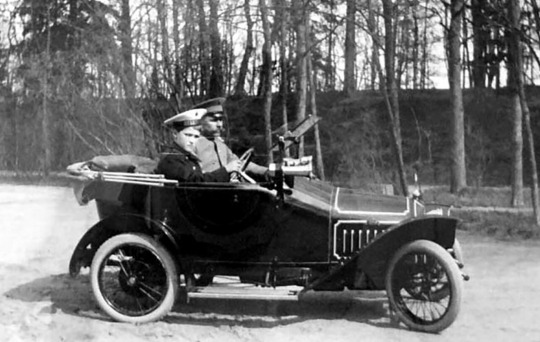


Like any boy, his age, Alexei got into the "motor" craze! (On the left he seems to be trying to learn how to change a tire). In the photo on top, he is driving a small car, his Peaugot "Bebe"
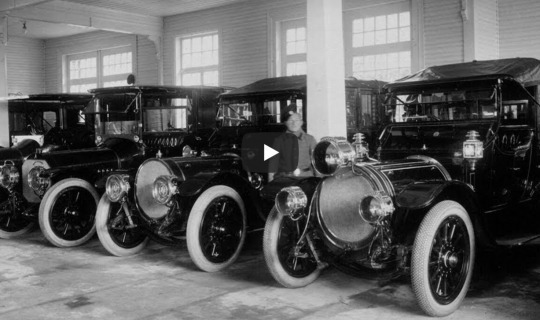
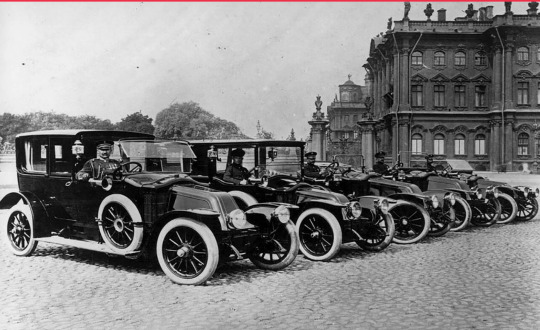
Some of Nicholas II's cars
Cars gave Count Fredericks, Nicholas' court minister, many headaches. He had a difficult time getting Nicholas to buy his first car, but then he could not make him stop getting new ones. Nicholas bought his first car in 1905. By 1917, he had 56 cars in his garages…more than any other European Court.
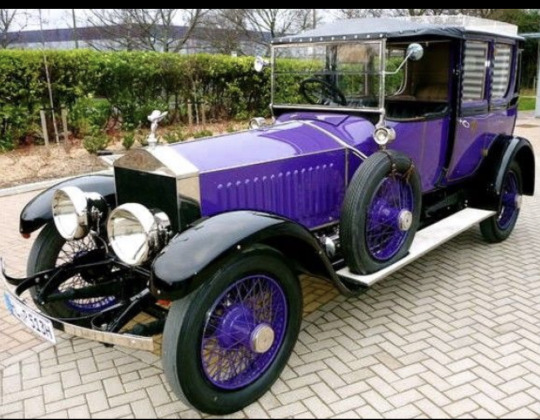
Nicholas II ordered this car, a classic 1914-built Rolls Royce Ghost, the year before he was murdered; it is not known if or how long he used the car. It was bought by a collector at auction for an extraordinary amount.
References:
Alexander Palace Time Machine. (retrieved 2024, April 24). The Imperial Garage: The Tzar and his cars. Blog: https://www.alexanderpalace.org/palace/impgarage.php
Manaev, Georgy. (2022, May 11). Nicholas II Awesome Car Collection. Blog: https://www.rbth.com/history/335016-nicholas II-garage-car-collection
118 notes
·
View notes
Photo

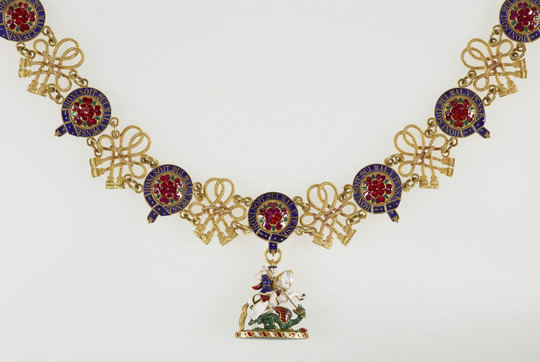
Emperor Alexander II of Russia’s investiture badge (Lesser George) of the Order of the Garter & collar and badge (Great George) of the Order of the Garter, 1867. (x)
Emperor Alexander II was invested ‘with the Ensigns and Habit’ of the Most Noble Order of the Garter in the Throne Room of Tsarskoe Selo on 28 July 1867 (NS). He was invested by George Henry Robert Charles, Earl Vane (later 5th Marquess of Londonderry), who had been appointed as Queen Victoria’s Envoy Extraordinary to lead the Garter mission to St Petersburg.
The Earl was accompanied by the eight other members of the Mission - which included the future Duke of Marlborough, three officials of the College of Arms; Deputy Garter, Chester Herald and the Rouge Dragon Pursuivant of Arms, and Major General Lord Henry Percy and Major Christopher Charles Teesdale – both of whom had won the Victoria Cross during the Crimean War. The inclusion of two recipients of the Victoria Cross was not insignificant because part of the rationale to appoint the Emperor to the Order was to help heal the wounds of the conflict some 10 years earlier.
The insignia was supplied by Garrards. The cost of the insignia and other items, 3 silver gilt boxes, mantle, Garter Shield, seven velvet cushions with tassels (for the investiture ceremony), the silver underhabit, plume, materials for the banner in St George’s Chapel, trunks for transportation, Garter ribbon and binding of the statutes came to £538-2–0.
The Mission left London on 18 July, arriving in St Petersburg on the 24th. The suite was received in Audience with the Emperor on 26 and 27 July. On the morning of the 28th they travelled in five royal state carriages with outriders and grooms in state liveries from the Alexander Palace to the Catherine Palace and were met by a guard of honour. They then processed to the Throne Room, with Major Teesdale bearing the hat, plume and star, Viscount Canterbury the collar, Lord Henry Percy the sword, the Marquess of Blandford the Mantle and cordon, George Adams (Rouge Dragon Pursuivant) the Garter, riband and George while the rest of the party carried the Queen’s commission and a copy of the statutes of the Order.
The Emperor wore his Garter Insignia at the time of the marriage of his daughter Grand Duchess Marie Alexandrovna to Prince Alfred, Duke of Edinburgh, in January 1874 and during his subsequent visit to London in May that year. They were, in sadder times, to form part of the display of the Emperor’s insignia at his funeral after his assassination in 1881. Following the funeral, the insignia was returned to London with the star and badge displayed at Queen Victoria’s command at Windsor Castle. | The Royal Collection
50 notes
·
View notes
Photo




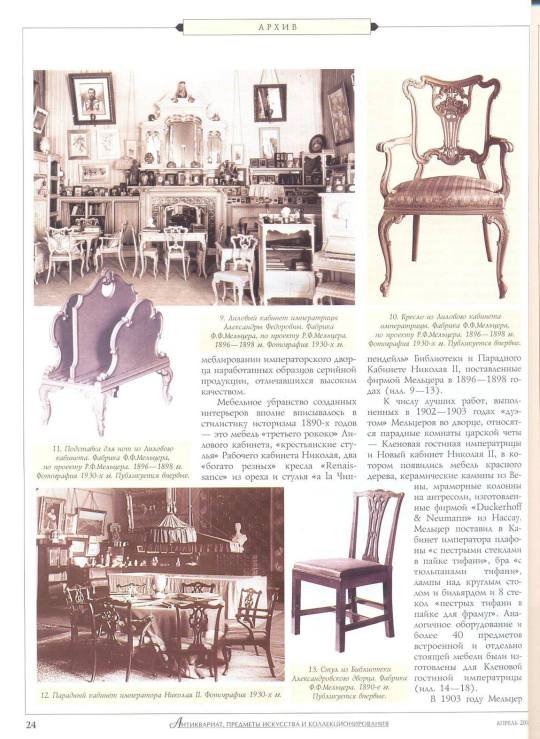


Sometimes searching in Russian really does pay off when you least expect it haha. Here is a lovely article published back in 2004, and authored by Mme. Iraida K. Bott, the Deputy Director for Scientific and Educational Work for the journal “Antiques, Objects of Art and Collectibles” which was active from 2002-2015.
Every manner of antique and archival material is discussed through-out the magazine’s publication. In the 16th Issue, back in April of 2004 the magazine published an article entitled:
DISCLAIMER: I do not know Russian, this was translated using a translator so I apologise for any errors. ^_^
“Tsarskoye Selo furniture by F. Melzer and N. Svirsky.”
The article itself goes into detail about the History behind the furniture which decorated the rooms of the Alexander Palace which were lived in by the Imperial Family.
“From the beginning of the twentieth century we are only one century, but in the palace meetings Petersburg remained, paradoxically, much less subjects of the time, than, say, the end of the XVIII or early XI centuries.
However, the paradox can be explained quite simply: interest in subjects of the era of historicism and modernism appeared in our country only in recent decades, but still earlier than the opportunity to freely study the objective world of imperial palaces and the artistic preferences of their owners. By this time, revolutions, wars and ideology destroyed much that had, if not artistic, then memorial value, so important for the preservation of historical memory.
In this respect, the last house of the last emperor of Russia is interesting - the Alexander Palace in Tsarskoe Selo, a kind of repository of information about time and people, which ceased to exist during the Great Patriotic War. Only those items taken out for evacuation, and therefore preserved individual items, as well as the memories of the owners and eyewitnesses, archival materials and photo chronicles, allow, albeit sketchily, to reconstruct the subject environment, undoubtedly interesting for the historian.
I would like to note that the furniture , which was perceived as a utilitarian component of the room, was especially damaged from all the decoration of the palace chambers . Indeed, the residential and ceremonial interiors of the palace included not only specially made items, but also samples of mass production of the capital’s factories. Perhaps that is why in the post-revolutionary years, furniturethey were distributed from the Alexander Palace to various state institutions and practically were not evacuated during the war years. Today we evaluate time and its material monuments in a different way. We are interested in both works created according to the projects of architects for a specific interior, and serial products produced by leading domestic manufacturers. It is important to note that many of the similar items are found in homes and on the antique market today, so information about the furnishings of the Tsarskoye Selo palace can identify unnamed objects that exist.
From 1905 to August 1917, the Alexander Palace in Tsarskoe Selo became the favorite home of Nicholas II and his family. The emperor was born in the Tsarskoye Selo palace and retained his love and affection for this place throughout his life. Here in 1894, shortly after the wedding, he brought Alexandra Fyodorovna; the young married couple stayed in the rooms of the left wing where Nikolai Alexandrovich spent his childhood.
By the next stay of the royal couple in several rooms of this half, they made repairs, put in order the furniture that was here during the time of the great-grandfather of Nicholas II . Perhaps, taking into account the Empire style of furniture, in the corner living room of the left wing, where Nikolai and Alexander stayed for the first time, they installed Karelian birch doors, borrowing them from the former rooms of Nicholas I, and, in accordance with them, according to the drawings of the architect of the Tsarskoye Selo palace administration S. A. Danini (1867-1942), FF Meltzer’s firm made two glazed cabinets, also from Karelian birch. Furniture created in the 1820s for Nikolai Pavlovich according to V. Stasov’s designs in A.K. Tour.
The decoration of the premises of this wing continued in the following years, in connection with this, in 1896, the name of the manufacturer N.F. Svirsky appeared in the palace documents for the first time, who became the supplier of the court under Alexander III and worked a lot for Nicholas II. At the request of Alexandra Feodorovna, this metropolitan master was entrusted with "making furniture for a bedroom and a ladies’ dressing room, with a bathtub and a water closet cladding” “according to samples and outline tracing papers brought by Her Majesty from abroad.”
In the late 1890s, Svirsky’s factory delivered several more items and sets of furniture to the palace: an icon case for the bedroom of the senior princesses, possibly according to the drawing of the already mentioned S.A. Danini, a corner sofa in the Louis XVI style - for the Empress’s Corner Drawing Room, furniture with painting and gilding - for the Portrait Hall (ill. 1, 2). For the same interior, Svirsky made six chairs “carved gilded wood, in the style of classicism, imitating the Jacob chairs,” repeating the forms and decor of the living room set by J. Jacob from the Arabesque hall of the Catherine Palace, transferred to the Alexander Palace at the request of Nicholas II and Alexandra Feodorovna.
Small carved gilded tables with round and rectangular white marble countertops were made for the Empress’s Corner Living Room at the Svirsky factory in the Louis XV style, the base of which was decorated with garlands hanging from bows, with bucranium heads - a typical classicist motif. Graceful legs ended with hooves and were connected by a beautifully shaped prong with a chiseled vase in the center. These objects are examples of exquisite stylization, in which one can see the hand of a skilled draftsman, whose name has not yet been established (ill. 3).
The attention and interest in the historical setting, characteristic of the last owners of the palace, was probably due to the architectural design of the ceremonial halls, which corresponded to the solemn and elegant classicist decoration. From the correspondence of the Dowager Empress Maria Feodorovna, it became known that the nature of the interiors was largely determined by the artistic inclinations of the hostess, Empress Alexandra Feodorovna. As Yuri Kudrin notes in the book “Empress Maria Feodorovna Romanova. Diaries. Letters. Memories “(M., 2000), in January 1896, after visiting new apartments in the Winter Palace, Maria Fedorovna, criticizing the taste of her daughter-in-law, in particular, wrote:” .. they [Nikolai and his wife - IB] had the unfortunate idea of choosing an Empire style, which I hate to such an extent that for me it’s just ah, and I would not want to live there for anything in the world. Hopefully, this will all look better over time as everything here is replenished and settled. The main thing is that they like it: Alix loves this terrible Empire style, and since she will live here, everything is done according to her taste, and she is very happy. “
In 1909, ”… The Empress Alexandra Feodorovna deigned to choose a drawing marked with a red cross, and ordered chairs for tables in the round hall of the Alexander Palace to be made from it,“ where the family usually gathered during ceremonial breakfasts. 48 beech chairs, covered with enamel paint and decorated with gilded Empire decor, were made according to the design of the architect Danini at the factory of F.F. Melzer. The appearance of these objects in one of the most elegant halls of the palace not only testified to the fashionable retrospective direction in Russian art of the 1910s, but was dictated by the interior architecture and decoration of the hall. It is interesting to note that two sketches were presented to the Empress for consideration and approval, of which the crowned customer chose, it seems, the best option (ill. 4, 5).
For many years, the artistic tastes of the last Romanovs were usually scolded in our country. Indeed, the residential apartments of Nicholas II and Alexandra Feodorovna did not differ in sophistication of decoration and were "saturated … with items of factory production, characteristic of the industrial-capitalist class,” as the curator of the palace-museum V.I. Yakovlev wrote in 1928. However, it can be assumed that for Nicholas and his family, the comfort and warmth of human communication were more important than fashionable and elegant decoration, to which little attention was paid. Suffice it to recall that the interiors in the Winter Palace were designed only for the wedding, and the living rooms of the Alexander Palace, which became a favorite home, were created in two stages - in the 1890s and 1900s, and for two decades they practically did not change (Fig. 6 , 7). Nevertheless, today it is difficult to deny that the best architects and leading metropolitan masters of their time worked at the order of the imperial family, and such interiors, II in Aleksandrovsky, - among the best interiors of the turn of the century.
The most significant works in Tsarskoe Selo are associated with the names of the already mentioned FF Meltzer and his brother RF Meltzer. For the right wing of the Alexander Palace, which became the residential half of the royal family, according to the designs of the court architect , the decoration of all residential and ceremonial premises was created at the factory of the court furniture supplier.
Work here began in the winter of 1896, and in the first year of their stay in the palace, the new owners were content with the furnishings preserved from the previous owners. If pieces of furniture appeared here, then those that were not specially created, but were selected from those offered by the manufacturers. So, in 1895, from the supplier of the imperial court and the court of the Grand Duke Vladimir Alexandrovich, K. Greenberg, who had been manufacturing furniture for the Alexander Palace during the reign of Alexander II , in the Bedchamber of Their Majesties they purchased “ furniture at agreed prices, painted with lacquer paint in tones “, upholstered in chintz with a pattern -” on a white background, round medallions of flowers. Judging by the small number of items indicated in Greenberg’s account, as well as by the mention that at the same time in the Bedchamber “the old furniture was painted again with lacquer paint in tones,” the manufacturer only supplemented the existing decoration of the room, updated for the stay of the royal couple (Fig. 8).
The products of Karl Greenberg ’s small furniture and upholstery workshop, in which 30 apprentices and five apprentices worked in the 1880s, was awarded a medal at the Paris Exhibition of 1878 and the Big - a silver medal received in 1885 from the city of St. Petersburg - “for a very good furnishing and upholstery work ”, Greenberg supplied and refurbished furniture in the palace for several decades. Large ash wardrobes with sliding doors for the wardrobes of the Emperor and Empress, two of which have survived to this day, were made by him in the 1890s.
By September 1896, in the Alexander Palace, in addition to Opoch-valna, the Rosewood drawing room and the Lilac study (room “ mauve ”) were ready for the Empress’s half, the Restroom and the Study for Nicholas II . The decoration of these rooms was created at the factory of FF Meltzer according to the designs of the architect RF Meltzer, who included 10% in his brother’s estimate documentation - “for drawing up drawings and technical supervision of painting, plastering and stove works”. The volume and terms of the order are impressive: for the Lilac office alone, the factory produced more than 30 pieces of lacquered furniture, and, as FF Meltzer wrote in his commitment, “the deadline for the execution of the main aforementioned works, including drawing up drawings, patterns, models, is 2 1 / 2 months". At the same time, Melzer not only made furniture, panels and “veneered pianos in the style of a room,” but also put tagans, lighting equipment, fireplaces, fabrics on walls and window fittings. The short terms of execution of the order were due to the large and well-established production and the use of proven samples of serial production, distinguished by high quality, in the furnishing of the imperial palace.
The furniture of the created interiors fit quite well with the historicism style of the 1890s - this is the furniture of the “third rococo” of the Lilac office, the “peasant chairs” of Nikolai’s study, two “richly carved” armchairs “ Renaissance ” made of walnut and chairs “a la Chippendale” Libraries and the State Office of Nicholas II , supplied by Meltzer’s firm in 1896-1898 (ill. 9-13).
Among the best works performed in 1902-1903 by the “duet” of the Meltzer’s in the palace are the state rooms of the royal couple - the Maple Drawing Room of the Empress and the New Study of Nicholas II , in which mahogany furniture , ceramic fireplaces from Vienna, marble columns on mezzanines made by Duckerhoff & Neumann from Nassau. Meltzer put in the Emperor’s Cabinet plafonds “with variegated glasses in tiffany soldering”, sconces “with tiffany tulips”, lamps over a round table and billiards, and 8 glasses “motley tiffany soldered for transoms.” Similar equipment and more than 40 pieces of built-in and free-standing furniture were made for the Empress’s Maple Drawing Room (Figures 14-18).
In 1903, Melzer completed a large amount of work in the children’s rooms, the corridor and the Corner Room of the upper floor, for which the furniture made of ash and oak was painted in ivory and maple green. In the rooms of the emperor’s children, objects were painted in ivory and decorated with pink, blue and green stripes, combined with the Chin designs on the walls and draperies on the windows. At that time, white painted furniture was in vogue: in 1895, on the name day of Grand Duchess Olga, sister of Nicholas II , the imperial “gave her various white furniture covered with beautiful chintz”; painted objects were also in the Empress’s purple study.
Some furniture today, items from the rooms of the imperial children can be seen in the collection of the State Hermitage, in pre-war photographs, watercolors of the 1930s, and on projects by the architect of the court office, Danini (ill. 19). Among them is a drawing of a dining room wardrobe designed by him in the 1900s, and a drawing of an icon case for the heir’s bedroom. The children’s dining room - an almost square room with two windows to the park - was located above Alexandra Feodorovna’s service quarters. As in other interiors, its walls were covered with an English chin, which the empress considered a hygienic material suitable for children’s apartments. In the dining room there were: a dining table, a sideboard, several side tables and Viennese chairs with overhead cushions. It is interesting to note that the chairs were of different heights - in accordance with the age and height of the Grand Duchesses.
Danini also belongs to the project of the icon case for the bedroom of Tsarevich Alexei, made at the Melzer factory. “A cabinet with six compartments with closed cabinets in the lower part, painted in ivory and decorated with twisted columns and flat carvings, was located in the corner of the room and was filled with icons of the“ new letter ”in vestments or frames, as well as images, crosses, etc. porcelain with Easter eggs. The same icon cases with icons were in the bedrooms of all the august children (ill. 20, 21).
All work in the Alexander Palace from the first years of the imperial couple’s stay in it was carried out under the supervision of Alexandra Feodorovna. The Empress approved the samples of the carpets; at her request, a fireplace was made from green majolica tiles in a nickel-plated frame in the ladies’ dressing room; lamps of her choice were installed for electric lighting, and even samples of bronze handles for doors and windows were submitted to her; fulfilling her desire, Danini was instructed to write, according to the available samples from Darmstadt - the empress’s hometown - wallpaper for the upper floor of the left wing of the palace, etc. Alexandra Feodorovna lovingly landscaped her house, using all the technical achievements of that time to create coziness and comfort. So, for example, in 1897 the Empress ordered “in their Majesties’ own chambers and in the rooms of Grand Duchess Olga Nikolaevna.
This house was filled with things that reminded the owners of private and official events of their lives, favorite books and photographs of relatives and friends, it smelled of flowers, which Alexandra Fyodorovna loved very much, the House in the Alexander Palace pleased the family of Nicholas II and, leaving it early in the morning on August 1, 1917 years, they hoped to return to Tsarskoe…
This, however, did not happen, and the history of the palace after the Romanovs turned out to be as tragic as the fate of its last inhabitants, and the preserved objects still cannot return to their historical places.“
30 notes
·
View notes
Photo
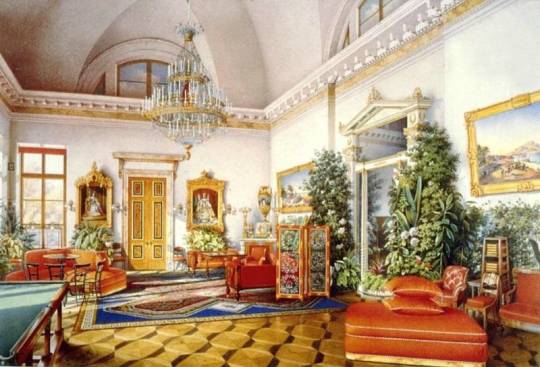

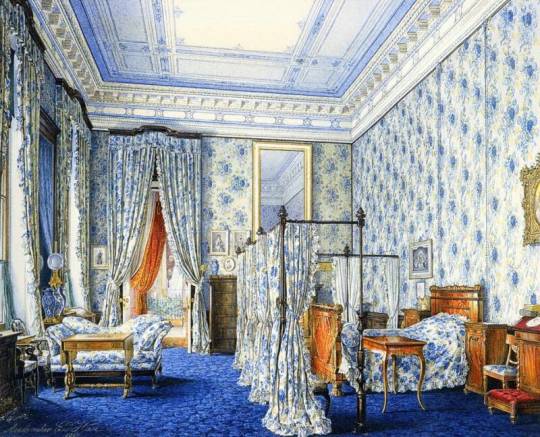
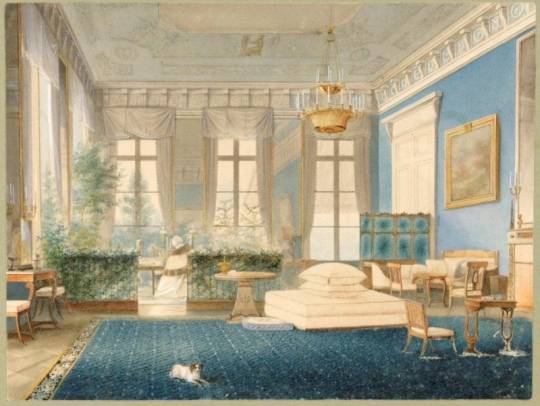

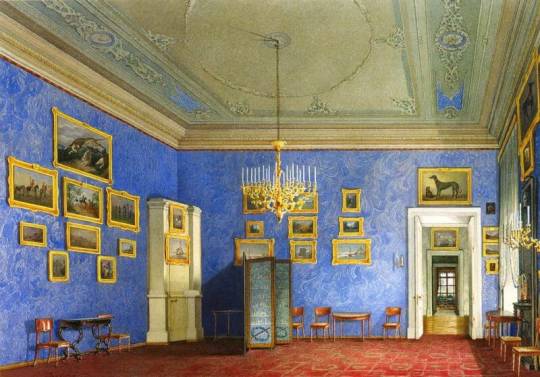


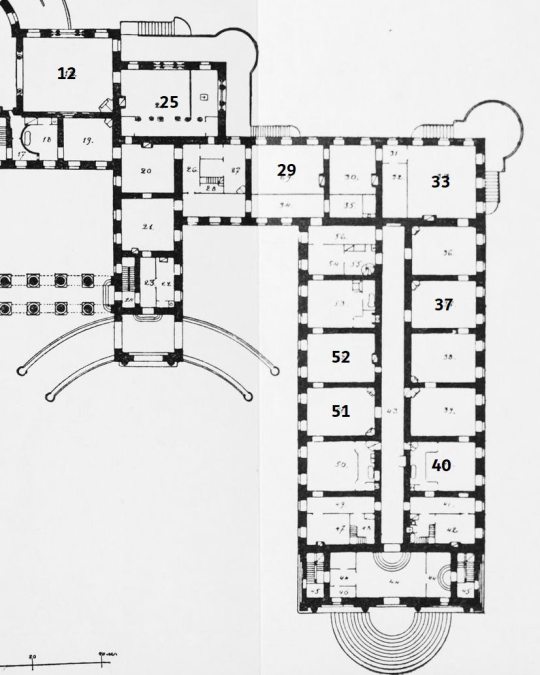
After doing some sleuthing in the Gosfond archive (the State Catalogue of the Museum Fund in Russia), I came across eight aquarelles or watercolours painted by various artists - some of their names are known, as some of the interiors depicted are main stream knowledge in regards to the Alexander Palace before the reign of Tsar Nicholas II.
All of the watercolours depicted were commissioned and finished during the reign of Tsar Nicholas I, and show the way the rooms looked during his life-time. Along with the watercolours themselves, I’ve attached a cropped detail of the Ground-Floor Plan (First-Floor in the United States, Ground-Floor in Europe) showing with bold numbering which watercolour corresponds with which room on the floor plan. The floor plan comes from the 1928 catalogue written by V.I. Yakovlev on the Alexander Palace and its decorations and furnishings.
The first two are of public knowledge, while the others are not so well known and it took me some time to figure out with some help from articles and reading to pin-point where exactly these rooms were located during the reign of Tsar Nicholas I.
Of these views, the one of the Cabinet or Study of Empress Alexandra Feodorovna (the consort and wife of Tsar Nicholas I) is not widely known. This room later was redecorated and became the Blue Living-Room of Empress Maria Feodorovna (the consort and wife of Tsar Alexander III).
The third view which shows the Bedchambre of Empress Alexandra Feodorovna, this later became the birthplace of the future Tsar Nicholas II.
During the reign of Tsar Nicholas II, much of the decoration of these rooms was changed greatly. In the 1890s, Empress Maria Feodorovna, had the firm of Maples & Co. in London furnish what became the “English Half” which was also called the “Maples Suite.” These rooms compromised of the front apartments of the western wing.
The view of the watercolour of the Dining-Room, later became the Reception-Room of Tsar Alexander III.
The artists in each of the captions of the watercolour views are as follows: Luigi Premazzi, Edward Gau and I. Volsky.
________________________________________________________________
1. No. 12. Aquarelle of the Marble Drawing-Room. Alexander Palace. Circa. 1834. Artist: Luigi Premazzi.
2. No. 25. Aquarelle of the Raspberry Living-Room. Alexander Palace. Circa. 1863. Artist: Luigi Premazzi.
3. No. 29. Aquarelle of the Bedchambre of Empress Alexandra Feodorovna. Alexander Palace. Circa. 1861. Artist: Edward Gau.
4. No. 33. Aquarelle of the Cabinet of Empress Alexandra Feodorovna. Alexander Palace. Date Unknown. Artist: Edward Gau.
5. No. 52. Aquarelle of the Cabinet of Tsar Nicholas I. Alexander Palace. Circa. 1860s. Artist: Edward Gau.
6. No. 37. Aquarelle of the Dining-Room. Alexander Palace. Circa. 1857.
Artist: I. Volsky.
7. No. 51. Aquarelle of the Class-Room. Alexander Palace. Circa. 1857.
Artist: I. Volsky.
8. No. 40. Aquarelle of the Bedchambre of the Grand Dukes. Alexander Palace. Circa. 1857. Artist: I. Volsky.
9. Cropped detail of the Ground-Floor Plan of the Alexander Palace showing the western wing where the rooms of Tsar Nicholas I and his family were primarily located. Circa. 1928.
Source: Gosfond (State Catalogue of the Museum Fund in Russia)
Link of courtesy: www.goskatalog.ru
27 notes
·
View notes
Note
🤍: who is your fav underrated royal.
💔which Royal deserved better?
🤍: Princess Elisabeth of Hesse
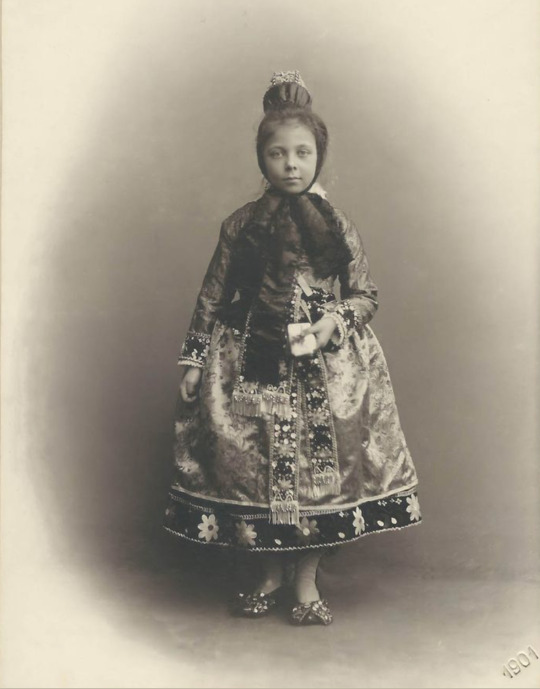
💔: Princess Victoria Melita of Edinburgh (Grand Duchess of Hesse and Russia)

Thank you for asking me questions!!!
39 notes
·
View notes
Photo

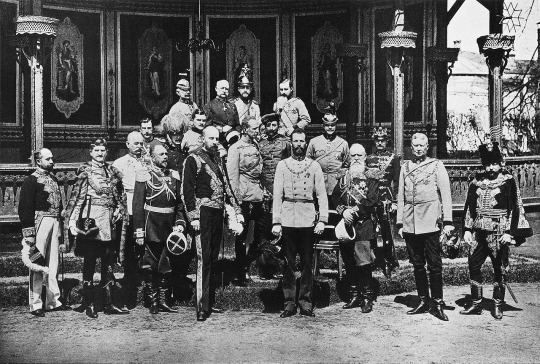
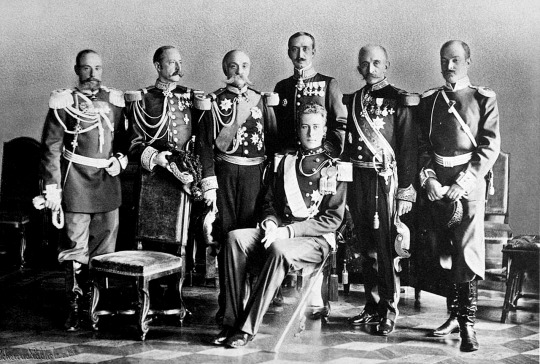



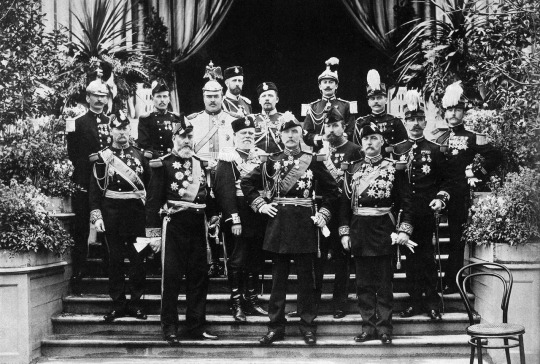
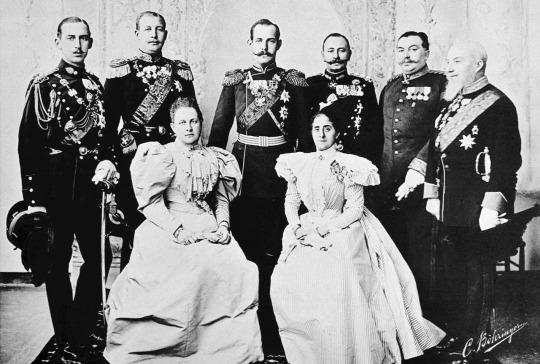
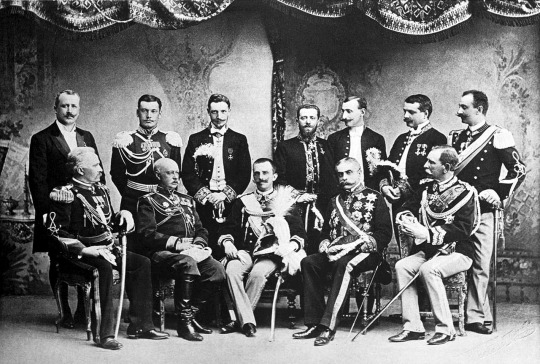
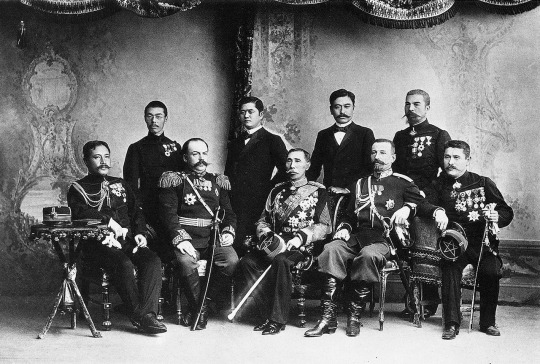
Diplomatic representatives at the coronation of the Emperor of All the Russias, 1896 (1/X)
1. His Most Rev. Ex. Monsignor Aliardi, Apostolic Nuncio to the Russian Empire (centre-left, front row) and the delegation of the Holy See - x
2. H. H. Prince Franz de Paula of Liechtenstein, Ambassador Ordinary and Plenipotentiary of the Austro-Hungarian Monarchy (later Franz I of Liechtenstein; centre-left, front row, with diplomatic uniform), with the Austro-Hungarian delegation - x
3. H. R. H. Prince Albert of Belgium, Prince of Saxe-Coburg and Gotha, Duke of Saxony (later Albert I of Belgium; seated), with the Belgian delegation - x
4. H. R. H. Prince Ferdinand of Bulgaria (later Ferdinand I; centre of front row) and Konstantin Stoilov, Foreign Minister of Bulgaria (at the Prince’s left), with the Bulgarian delegation - x
5. H. E. Li Hung-chang, Marquis Sui and Ambassador Extraordinary of the Great Ch’ing (centre-right, seated) with the Chinese delegation - x
6. H. R. H. The Crown Prince of Denmark (later Frederik VIII; centre, seated) with members of the Danish delegation - x
7. H. E. Division General Raoul Le Mouton de Boisdeffre, Ambassador Extraordinary of the French Republic (centre, front row), Vice-Admiral Jean-Charles-Alexandre Sallandrouze de Lamornaix (centre-left, front row) and Brigade General Joseph Jeannerod (centre-right, front row) with the French extraordinary delegation - x
8. H. M. The Queen of the Hellenes (née Grand Princess Olga Konstantinovna; left, sitting), H. R. H. Prince Nicolaos of Greece and Denmark (left, standing), H. R. H. Prince Georgios of Greece and Denmark (centre-left, standing), H. R. H. The Duke of Sparta (later Constantinos I; centre, standing), with members of the Hellenic delegation Colonel Konstantínos Sapountzákis (centre-right), the Queen’s Secretary (right, standing), court chamberlain Cpunt Denis Messalas (centre-right, standing) and Mrs. Sapountzákis, lady-in-waiting to Her Majesty The Queen of the Hellenes - x
9. H. R. H The Prince of Naples (later Vittorio Emanuele III of Sardinia; centre, sitting) and H. E. Marquis Carlo Maffei di Boglio, Ambassador Ordinary of the Kingdom of Sardinia (centre-right, sitting), with the Sardinian delegation - x
10. H. E. Prince Yamagata Aritomo, Ambassador Extraordinary of the Empire of Japan, with the Japanese delegation - x
The Royal Collection
42 notes
·
View notes
Text
1899
Portrait of Princess Elisabeth of Hesse
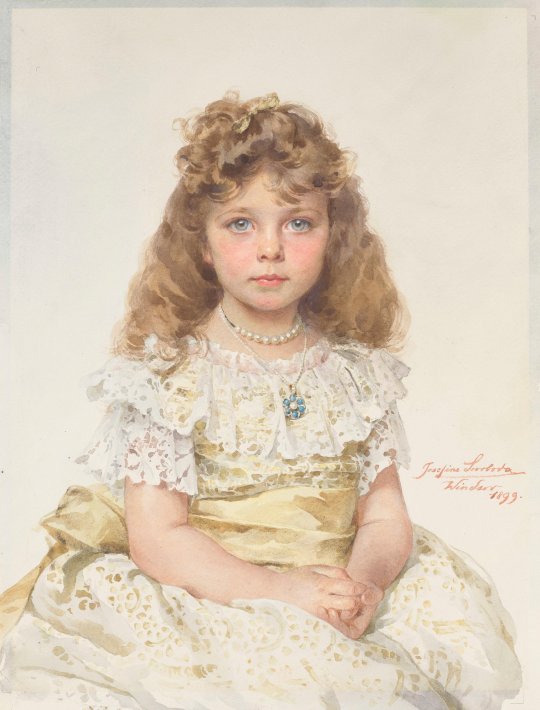
Portrait of Princess Elisabeth of Hesse by court painter Josefine Swoboda (1861-1924).
Watercolour.
Signed and dated on the lower right: “Josefine Swoboda. Windsor 1899”
Elisabeth is sitting and wears a dress of white lace and yellow silk. Round her neck is a large blue flower-shape pendant (the one Ernst Ludwig would posthumously add to a memorial golden chalice) as well as a tiny pearl band.
This portrait was probably made in Summer 1899, while Elisabeth stayed with her parents at Windsor visiting Queen Victoria.
At present, this portrait is housed in the Print Room at Windsor Castle, where it can be seen by appointment.
source: Royal Collection Trust.
Thank you princessvictoriamelita for sharing it with me, and thank you Thomas Aufleger for the extra information regarding the portrait.
103 notes
·
View notes
Text
1895
Letter excerpts from Alix to Ernst Ludwig.
Anitchkov Palace, Saint Petersburg. 19 January 1895
About what day do you hope the happy event to take place? You must be anxious –but I am delighted to hear Darling Ducky is so well. –Xenia I think expects in June –she is very well only paler than usual & I don’t think feels ever as sick as poor Ducky did.
Anitchkov Palace, Saint Petersburg. 12 February 1895
I am distressed to hear your poor little wife is suffering so, as I had been told she was so well & looking so pretty.
Saint Petersburg. 7 March 1895
I am so excited for news about Ducky & getting most impatient, –she says you have not determined about the names – a boy I should call Ludwig (Louis) – a girl Marie (May).
Saint Petersburg. 17 March 1895
I do wonder what you are going to call your little one, May, Alice or what. One of the names, not to hurt Darling Grandmama i suppose will be Victoria, but i am sure not the first –how splendid, A. Vicky could be godmother too & much flattered. –If Marie, I wonder whether you would ask A. Minny as Godmother or not? She was mine & I think Mays; – I do wonder what names!
Saint Petersburg. 24 April 1895
What a wide awake face the little one (Elisabeth) has got –too sweet!
Tsarskoe Selo. 4 November 1895
Letter sent to the New Palace, Darmstadt.
How is your sweet Baby? All admire the picture so much – it looks so pretty in my mauve room, & I feel very proud of my Godchild.
Source: The Correspondence of the Empress Alexandra of Russia with Ernst Ludwig and Eleonore, Grand Duke and Duchess of Hesse. 1878-1916.
31 notes
·
View notes
Text
1895
Letter excerpts from Alix to Ernst Ludwig.
Peterhof. 25 July 1895.
Letter sent to Wolfsgarten Castle, Egelsbach.
My darling Ernie dear,
This minute I received a sweet letter from dear Ducky, which gave me great pleasure, as I had not heard from her since a very long time – she is so lonely without you, I cannot understand how she could separate herself from you & the tiny Baby. What a love she (Elisabeth) must be now in her short frocks – it seems too strange to me, your being a father, but how you must adore her I can well imagine.
Alexandria, Peterhof. 30 August 1895.
Letter sent to Coburg and forwarded to Rosenau, Öslau.
My darling Ernie dear,
I see by the papers that you are again alone, and that Ducky, the bad penny, has left you for Coburg… I have finished Baby’s (Elisabeth) quilt, & Paul will bring it to Wolfsgarten.
Peterhof – Saturday, 14 September 1895
Letter sent to Wolfsgarten Castle, Egelsbach, and forwarded to Romrod.
Fancy Baby (Elisabeth) having already 3 teeth, she is in a hurry! How proud you both must be of her.
Tsarskoe Selo – 14 October 1895
Letter sent to Wolfsgarten Castle, Egelsbach.
My darling Ernie dear,
With all my heart I thank you for the lovely picture of sweet Baby; it touched me deeply your having sent it me, & was such an immense surprise when Ella brought it me this morning. It shall quickly be framed & hung up.
Tsarskoe Selo – 24 December 1895
– How happy you must be to have yr Baby again – she no doubt looks like a giantess after our little One (Olga Nikolaevna).
Source: The Correspondence of the Empress Alexandra of Russia with Ernst Ludwig and Eleonore, Grand Duke and Duchess of Hesse. 1878-1916.
28 notes
·
View notes
Text
got curious while watching the great so i looked up black people in imperial russia, and found this gentleman:
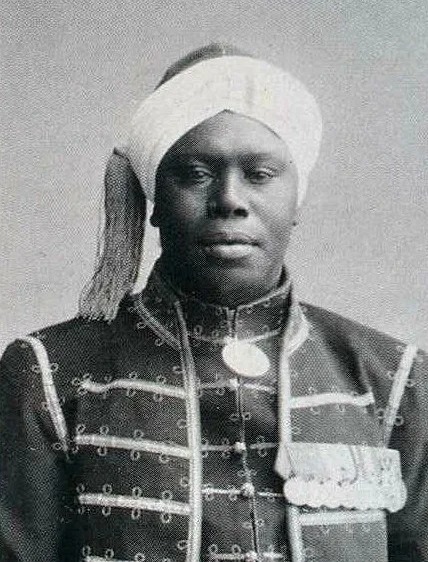

his name is georgiy nikolaevich maria, originally from cabo verde, and he became a servant of the imperial court in 1878
back then, there existed a title of арап ("arap"), which was basically a darkskinned servant, which became the fashion in the royal court circa late 17c. this is problematic for obvious reasons, but at the time it was considered a rather prestigious title. araps received higher pay than the white servants and had their own apartments with all the modern amenities, as well as access to free healthcare at the court hospital, they would later receive a retirement pension, and could take out a government loan for their children's education.
maria was one of the nine "araps of the highest court" during the end of 19c/beginning of 20c. they were required to be subjects of the russian empire and to convert to christianity. araps were also allowed to marry russian women, which maria did as you can see above. one of his sons became an arap as well, and his descendants live in russia to this day
this is the first time im seeing an old timey photograph of a black russian man, hence wanted to share
(sources: 1 2 3)
1K notes
·
View notes
Photo
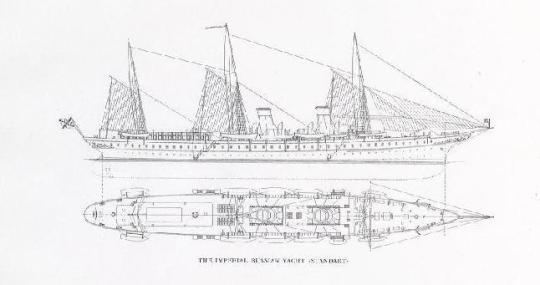
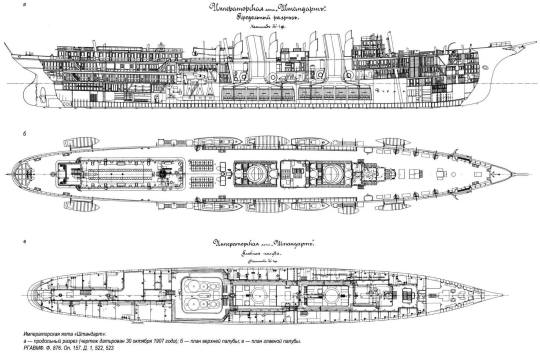

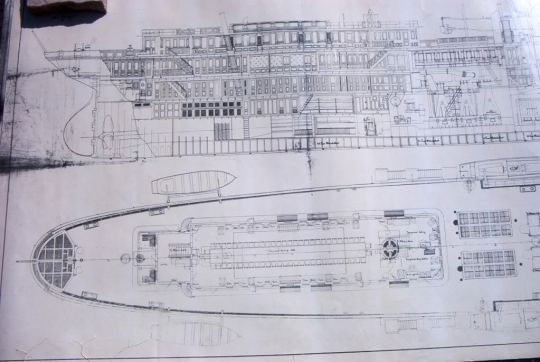
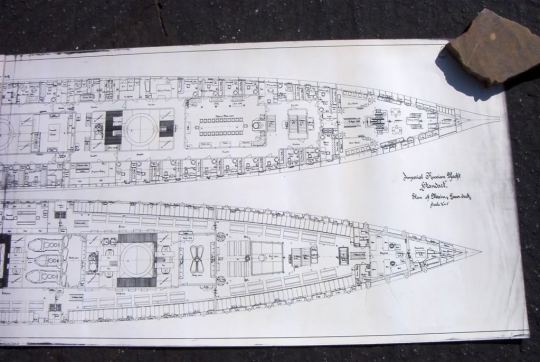

Deck-Plans of the Russian Imperial Yacht “Shtandart.”
Courtesy of www.yachtstandart.com, various Russian websites and from the private collection of Mr. Douglas W. Huntzinger. Mr. Harald Hendriksen is the purveyour of www.yachtstandart.com and has six deck-plans/schematics of the vessel himself. Please do enjoy these, more to come! :)
6 notes
·
View notes
Photo
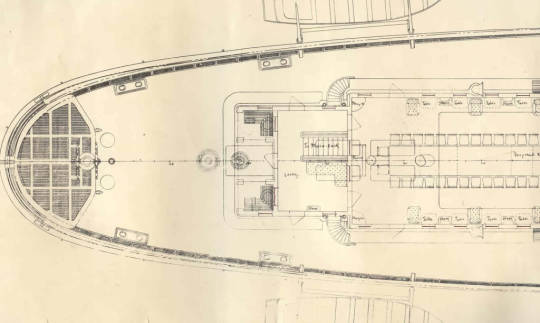
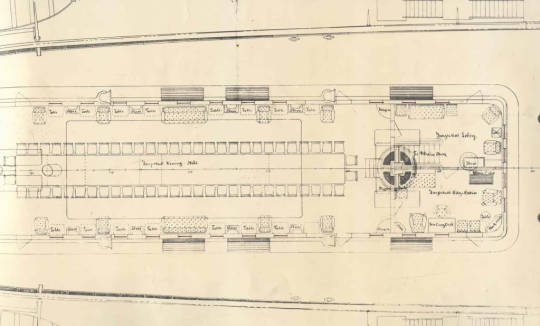
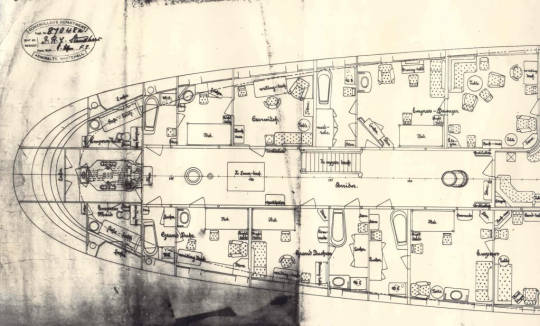

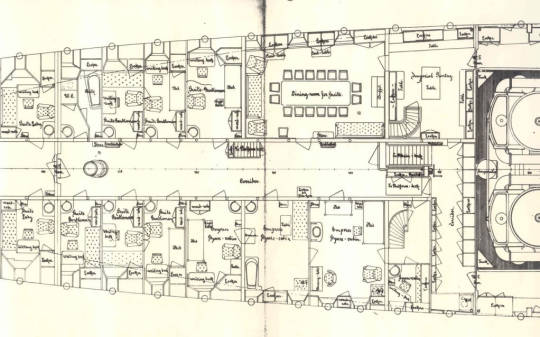

Deck-Plans of the Russian Imperial Yacht “Shtandart.”
Courtesy of Mr. Douglas W. Huntzinger. These come from his private collection and as he and Mr. Hendriksen have informed the public domain, they can be found and bought as a copy from the National Maritime Museum in Great Britain in Greenwich. Enjoy these as well! The details are stunning and very thorough. :)
9 notes
·
View notes
Photo
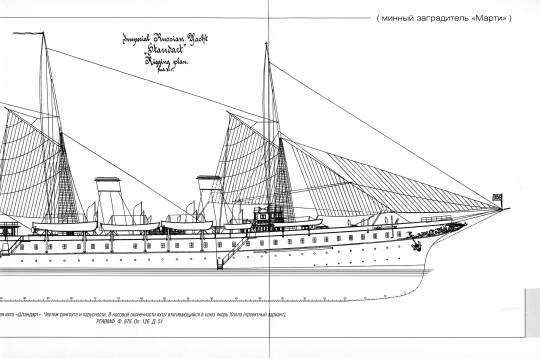
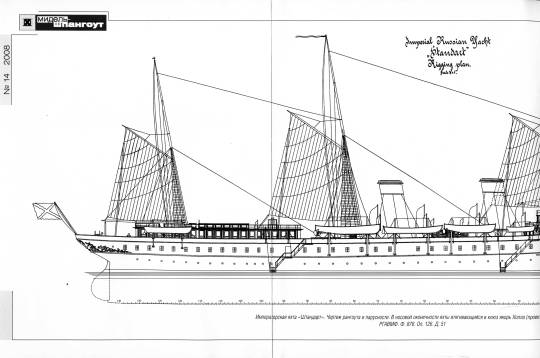
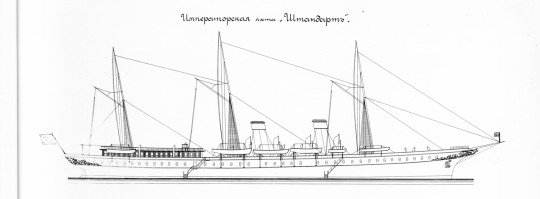

Deck-Plans of the Russian Imperial Yacht “Shtandart.”
MAGNIFICENTLY detailed and VERY good quality plans of the Rigging, Cross-Section and a Water-line plan of His Imperial Majesty’s Yacht, “Standart.” Please do enjoy these! :)
7 notes
·
View notes
Text

Prince Francis Joseph and Princess Anna of Battenberg at Wolfsgarten, 1907.
Source: Hessian State Archive.
40 notes
·
View notes
Text
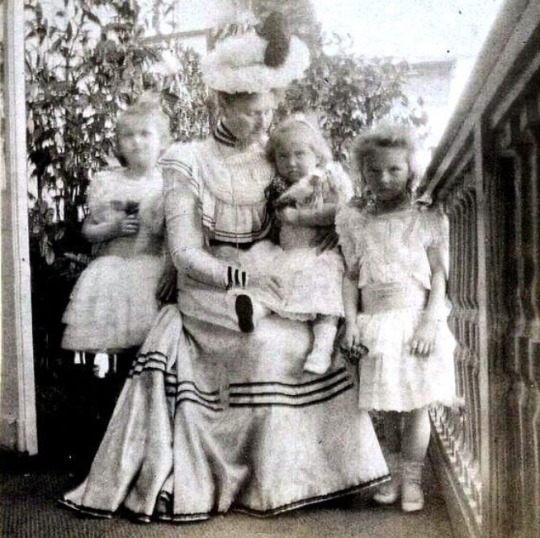
Tsarina Alexandra with Olga, Tatiana and Maria.
(source: Instagram)
101 notes
·
View notes
Photo

Photograph of Nicholas II and Franz Juravsky sawing a fallen tree at Tsarskoye Selo.
(source: Royal Collection)
66 notes
·
View notes